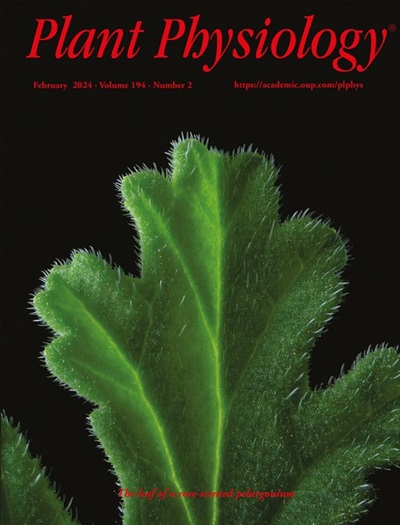早花 3 等位基因影响大白菜昼夜节律钟的温度响应性
IF 6.5
1区 生物学
Q1 PLANT SCIENCES
引用次数: 0
摘要
温度是诱导昼夜节律钟的环境线索,它使昼夜节律钟适应不同地理区域的当地热和光周期条件。人们对叶菜类蔬菜(如大白菜)的昼夜节律钟热适应性知之甚少,但它对在不断变化的气候条件下维持和提高蔬菜产量至关重要。我们研究了在 14、20 和 28 °C条件下生长的天然大白菜品种的昼夜节律性。昼夜节律周期在 20 °C时明显短于14 °C或28 °C,对温度升高和温度补偿(Q10)的反应与种群结构有关。全基因组关联研究图谱确定了温度补偿的变异,温度从20 °C上升到28 °C时的Q10值是温度补偿的测量值。单倍型分析表明,B. rapa早花3 H1等位基因(BrELF3H1)在20至28 °C时的Q10值显著高于BrELF3H2。对来自 BrELF3H1 × BrELF3H2 杂交的 F2 群体的共分离分析表明,BrELF3 等位基因之间的变异决定了大白菜在 20 °C 下昼夜节律周期的变异。然而,它们对昼夜节律振荡的不同影响在 28 ℃ 时有所减弱。拟南芥elf3-8突变体的转基因互补验证了BrELF3参与了昼夜节律钟对热线索的反应,在20至28 °C时,BrELF3H1比BrELF3 H2赋予更高的Q10值。因此,BrELF3 对大白菜昼夜节律钟对环境温度的反应至关重要。这些发现对于培育具有更强抗极端温度能力的新品种具有明显的意义。本文章由计算机程序翻译,如有差异,请以英文原文为准。
EARLY FLOWERING 3 alleles affect the temperature responsiveness of the circadian clock in Chinese cabbage
Temperature is an environmental cue that entrains the circadian clock, adapting it to local thermal and photoperiodic conditions that characterize different geographic regions. Circadian clock thermal adaptation in leafy vegetables such as Chinese cabbage (Brassica rapa ssp. pekinensis) is poorly understood but essential to sustain and increase vegetable production under changing climates. We investigated circadian rhythmicity in natural Chinese cabbage accessions grown at 14, 20, and 28 °C. The circadian period was significantly shorter at 20 °C than at either 14 or 28 °C, and the responses to increasing temperature and temperature compensation (Q10) were associated with population structure. Genome-wide association studies mapping identified variation responsible for temperature compensation as measured by Q10 value for temperature increase from 20 to 28 °C. Haplotype analysis indicated that B. rapa EARLY FLOWERING 3 H1 Allele (BrELF3H1) conferred a significantly higher Q10 value at 20 to 28 °C than BrELF3H2. Co-segregation analyses of an F2 population derived from a BrELF3H1 × BrELF3H2 cross revealed that variation among BrELF3 alleles determined variation in the circadian period of Chinese cabbage at 20 °C. However, their differential impact on circadian oscillation was attenuated at 28 °C. Transgenic complementation in Arabidopsis thaliana elf3-8 mutants validated the involvement of BrELF3 in the circadian clock response to thermal cues, with BrELF3H1 conferring a higher Q10 value than BrELF3 H2 at 20 to 28 °C. Thus, BrELF3 is critical to the circadian clock response to ambient temperature in Chinese cabbage. These findings have clear implications for breeding new varieties with enhanced resilience to extreme temperatures.
求助全文
通过发布文献求助,成功后即可免费获取论文全文。
去求助
来源期刊

Plant Physiology
生物-植物科学
CiteScore
12.20
自引率
5.40%
发文量
535
审稿时长
2.3 months
期刊介绍:
Plant Physiology® is a distinguished and highly respected journal with a rich history dating back to its establishment in 1926. It stands as a leading international publication in the field of plant biology, covering a comprehensive range of topics from the molecular and structural aspects of plant life to systems biology and ecophysiology. Recognized as the most highly cited journal in plant sciences, Plant Physiology® is a testament to its commitment to excellence and the dissemination of groundbreaking research.
As the official publication of the American Society of Plant Biologists, Plant Physiology® upholds rigorous peer-review standards, ensuring that the scientific community receives the highest quality research. The journal releases 12 issues annually, providing a steady stream of new findings and insights to its readership.
 求助内容:
求助内容: 应助结果提醒方式:
应助结果提醒方式:


